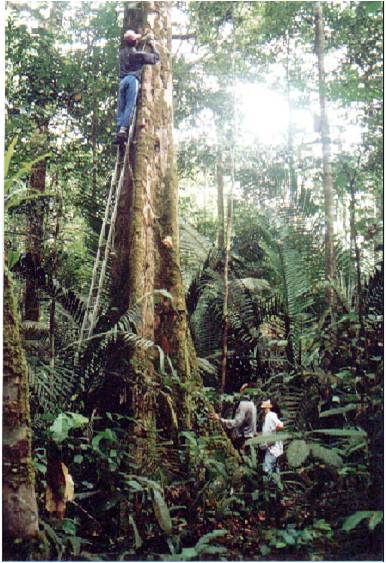Languages
Biological Inventories
The inventory's main objective is to organize, then make available, information from biological surveys in the Amazon. The surveys in question all use RAPELD, a standardized methodology described below. The PPBio portal also provides information on other programs of long-term ecological research whose high-quality data and methodology make them comparable. Data is also provided from independent surveys that have used the RAPELD survey method.
Technical surveys of fauna and flora have to be financially viable. A variety of techniques have been developed for surveys of specific animal or plant groups, and many of them are effective - for those groups. However, when the costs of doing all the different surveys are added together, these biodiversity surveys become financially nonviable.
Using data from surveys based on a limited number of taxonomic groups does not lead to effective management decisions because the information cannot not appropriately satisfy all demands, they may also not produce options that are politically viable. There are many stakeholders in biodiversity including local and indigenous communities, wildlife fisheries and forest management professionals, laboratory-based scientists, conservationists, watershed management authorities, municipal governments and politicians, to name but a few.
Any long-term biodiversity survey needs to provide data required by the greatest possible number of users of that information. Therefore, to be effective and efficient, a combined system of survey and monitoring needs to be part of an integrated biodiversity program. A cooperative international setup, the Long Term Ecological Research network (LTER) is already in place. The Brazilian national system is known as PELD (Pesquisas Ecológicas de Longa Duração or ’’Long-term Ecological Research’’).
Until recently, LTER sites were distributed near education institutions (universities and research centers) with long traditions of research in a variety of ecosystems, especially in the south and southeastern Brazil. These sites have resulted in huge quantities of high quality research. But, their distribution provided uneven coverage across Brazil and meant most research was happening in regions with the highest income. As in other LTER sites around the world, PELD established sites with agendas of largely independent research. As a result, there was little or no standardization of methodologies, which has often made it difficult to compare the results obtained from different sites (Belovsky et al. 2004).
The bias for study sites to be located near large population centres (and hence places that are already comparatively well-studied) was even more exaggerated in Amazonia, where the only site in the LTER program is near Manaus, a city with a long tradition of biodiversity research. Funding from PPG7 (Pilot Program for the Protection of Tropical Forests in Brazil) to create centers of research excellence at the National Institute for Amazonian Research (INPA) and the Goeldi Museum (MPEG) helped further focus research in Manaus and Belém areas, cities that are home to the two largest federal universities in the Amazon basin. This lead to PELD establishing a series of long-term sites on an axis between Manaus and Belém. Not only did this mean that research methods would be standardized at each of the sites, so maximizing comparability, but it also meant that there would be a series of new sites at locations that were neither close to large population centres or existing research centres and their already-established sites of investigation.
Noting the uneven geographical coverage of biodiversity research in the country, especially in regions of rapid agricultural expansion (places not covered by the PELD-1 plot series), the Brazilian Ministry of Science, Technology and Innovation (MCTI) included inventories in the PPBio program. The PPBio sampling strategy follows the spatial design developed with the PELD-1 plot series. The strategy was based on the idea that to be effective and efficient, the design of surveys should have the following characteristics:
-
(1) be standardized.
-
(2) Allow integrated research into all biological groups (taxa).
-
(3) be big enough to be able to monitor all aspects of biodiversity and ecological processes.
-
(4) To be modular and so permit comparisons with less intensive sampling done on very large areas.
-
(5) To be compatible with exisiting initiatives.
-
(6) Be implementable with existing manpower. (Fieldwork)
-
(7) Provide data quickly and in a usable manner that meets the demands of the professionals involved with biodiversity and natural resource management, as well as other stakeholders
Explanations about each of the listed features and methods used by PPBio can be chosen from the links in the list above. Together, these characteristics allow the establishment of new PELD Sites and rapid assessments (RAP - Rapid Assessment Program) in critical or impacted areas. A preliminary description of the methodology (called RAPELD) is in Magnusson et al. 2005 in Biota Neotropica.


